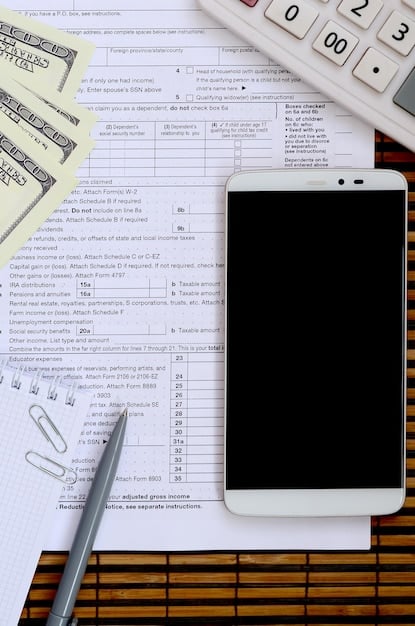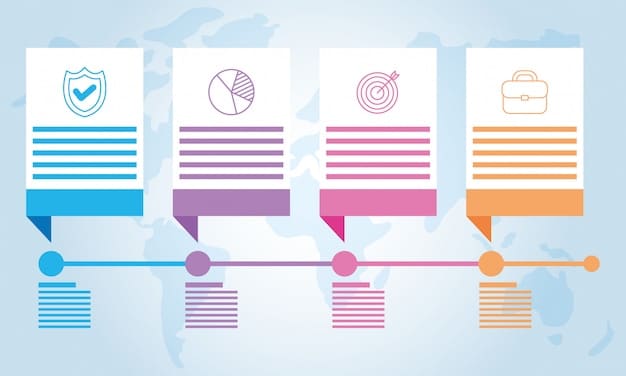Mastering 2025 IRS 1099-NEC Updates: A Guide for Entrepreneurs

Navigating the updated IRS Form 1099-NEC reporting requirements for 2025 demands proactive strategies, ensuring entrepreneurs maintain compliance, avoid penalties, and streamline their financial operations by understanding new thresholds, deadlines, and digital filing mandates.
As an entrepreneur, staying ahead of tax compliance is not just about avoiding penalties; it’s about strategic financial management. The Internal Revenue Service (IRS) continually refines its reporting mechanisms, and 2025 is set to bring noteworthy updates to the Form 1099-NEC (Nonemployee Compensation). Understanding how to prepare for the updated IRS Form 1099-NEC reporting requirements in 2025 is crucial for any business that relies on independent contractors, freelancers, or self-employed individuals. This guide aims to equip you with the insights and actionable steps needed to confidently navigate these changes, ensuring your business remains compliant and agile in the evolving tax landscape.
Understanding the Evolution of Form 1099-NEC
The Form 1099-NEC made its significant return for the 2020 tax year, primarily to address a specific issue: reporting nonemployee compensation. Before its reintroduction, this type of income was typically reported on Form 1099-MISC, leading to confusion and delays due to different filing deadlines for various income types. The IRS brought back Form 1099-NEC to simplify and streamline the reporting process for businesses paying independent contractors, freelancers, and other non-employees, setting a consistent January 31 deadline for both recipients and the IRS.
This dedicated form ensures that information on payments to self-employed individuals is precisely tracked, enabling the IRS to effectively cross-reference income reported by businesses with income claimed by contractors. For entrepreneurs, this means a clearer, albeit distinct, responsibility when it comes to reporting these payments. The separation of nonemployee compensation from other miscellaneous income streams on Form 1099-MISC aims to reduce reporting errors and improve the efficiency of tax season for all parties involved.

The intention behind the existence of 1099-NEC is to specifically capture payments made for services performed by someone not considered an employee. This includes payments to independent contractors, attorneys, accountants, and consultants, among others. It’s important to distinguish this from the 1099-MISC, which is still used for various other income types, such as rents, royalties, fishing boat proceeds, and other income payments.
As we approach 2025, the IRS continues to refine its processes, often introducing small but significant adjustments to reporting forms and regulations. These changes are usually aimed at enhancing accuracy, simplifying compliance, or adapting to new economic trends and technological advancements. Remaining informed about these subtle shifts is paramount, as even minor adjustments can have implications for how businesses collect, track, and report their payment data.
For entrepreneurs, understanding this historical context and the ongoing evolution is not just academic; it directly impacts operational efficiency and financial planning. By appreciating why the 1099-NEC exists and how it has functioned, businesses are better positioned to anticipate and adapt to future updates, ensuring a smoother compliance journey rather than a reactive scramble.
Key 2025 Updates: What’s New for Form 1099-NEC Filing
The IRS is continually refining its tax reporting ecosystem, and 2025 will introduce specific updates to the Form 1099-NEC that businesses must be aware of. While the core purpose of the form remains unchanged—reporting nonemployee compensation of $600 or more—there will be heightened emphasis on certain aspects, along with potential shifts in filing thresholds or digital mandates.
One of the most anticipated changes for 2025 involves the federal e-filing threshold. Starting in 2024, the IRS reduced the e-filing threshold for information returns (including all 1099 forms) from 250 to just 10 returns. This means that if you plan to file 10 or more 1099-NEC forms, you are now mandated to e-file them directly with the IRS. This change, while enacted for 2024 filings (due in 2025), is a critical update for many small to medium-sized businesses who might have previously relied on paper filing. It underscores the IRS’s push towards digitalization for greater efficiency and accuracy.
Digital Filing Mandates
- Reduced e-filing threshold: From 250 to 10 returns for all 1099 forms.
- Increased use of IRS’s IRIS: The Information Returns Intake System (IRIS) will become an even more primary method for free e-filing for businesses.
- Impact on paper filers: Businesses exceeding the new 10-return threshold must transition to digital filing methods or face potential penalties.
Beyond the e-filing mandate, the IRS is also consistently reviewing other aspects of tax compliance, including potential adjustments to penalty structures for non-compliance. While specific penalty increases for 2025 haven’t been widely publicized, the general trend indicates a stricter stance on late filings, incorrect information, or failure to file. This reinforces the importance of meticulous preparation and timely submission.
Consider also the ongoing efforts by the IRS to combat identity theft and improve data security. This might translate into enhanced verification requirements or new protocols for submitting highly sensitive taxpayer information. Businesses should anticipate a continuous push for more robust data handling and secure transmission methods when dealing with payment information.
Moreover, there could be subtle clarifications or expanded definitions regarding what constitutes “nonemployee compensation.” While broad categories typically remain stable, specific nuances in contractor relationships or payment structures might come under closer scrutiny. Staying informed through official IRS announcements and publications will be essential to ensure your interpretation of “nonemployee compensation” aligns with the latest IRS guidelines, particularly if your business engages in novel or complex contractor arrangements.
Data Collection and Verification Best Practices
Accurate data is the bedrock of compliance. For the 1099-NEC, this means meticulously collecting and verifying information for every independent contractor or non-employee to whom you’ve paid $600 or more for services rendered. The quality of your data directly impacts your ability to file correctly and on time, shielding your business from penalties and audits.
The primary tool for collecting contractor information is Form W-9, Request for Taxpayer Identification Number and Certification. This form provides the contractor’s legal name, business name (if applicable), address, and crucially, their Taxpayer Identification Number (TIN), which is typically a Social Security Number (SSN) or Employer Identification Number (EIN). It is paramount to obtain a completed Form W-9 from every contractor before making any payments, or at the very least, before the end of the tax year. Proactive collection prevents last-minute scrambling and potential delays.
Crucial Data Points to Collect
- Contractor’s Full Legal Name (as it appears on their tax return)
- Business Name (if operating as a business entity)
- Mailing Address (current and exact)
- Taxpayer Identification Number (SSN or EIN)
Beyond initial collection, verification is equally critical. A common pitfall is having incorrect or outdated W-9 information. You should cross-reference the information provided on the W-9 with other records if possible, especially if you suspect inaccuracies. The IRS offers a TIN Matching program, which allows payers to verify TINs and names against IRS records, significantly reducing the chances of B-notices (a notification from the IRS that a payee’s TIN doesn’t match their records).
Implementing a robust system for tracking payments is also essential. This means going beyond just total payments and categorizing them appropriately. Ensure your accounting software or tracking system is set up to clearly distinguish payments for services from other types of payments (e.g., product reimbursements, material costs) that may not be reportable on a 1099-NEC. Consistency in how you record and classify transactions throughout the year simplifies the year-end reporting process immensely.
It’s also advisable to communicate clearly with your contractors about their W-9s. Explain why you need the form and emphasize the importance of accurate and updated information. Sometimes, a simple email reminder in the final quarter of the year can help catch potential issues before filing deadlines. Educating contractors on their responsibilities regarding their tax information can foster a smoother process for both parties, highlighting a collaborative rather than confrontational approach to compliance.
Regular review of your contractor database for completeness and accuracy is a strong internal control. Even if a W-9 was correctly filed initially, addresses or business names can change. An annual review ensures your records are current, preparing you for seamless form generation at year-end. This proactive approach to data management transforms a potentially stressful compliance task into a routine business operation.
Leveraging Technology for Efficient Filing
In the evolving landscape of tax compliance, technology is no longer an option but a necessity, especially with the IRS’s increasing push towards digitalization. Leveraging the right tools can streamline the 1099-NEC filing process, reduce errors, and ensure timely submission, particularly for businesses now mandated to e-file.
Most modern accounting software, such as QuickBooks, Xero, or FreshBooks, offers robust features for tracking vendor payments and generating 1099 forms. These platforms often integrate directly with IRS e-filing systems or provide exports compatible with third-party filing services. The key is to ensure your software is correctly configured to identify nonemployee compensation payments throughout the year. This involves properly categorizing expenses and vendor types, so that at year-end, the data required for 1099-NEC is readily available and accurate.
Essential Technological Tools
- Accounting Software: For continuous payment tracking and automated 1099 generation.
- IRS IRIS (Information Returns Intake System): A free, web-based platform for e-filing 1099 forms directly with the IRS for eligible filers.
- Third-Party Filing Services: Platforms like Tax1099, eFileCabinet, or services offered by payroll providers for comprehensive 1099 preparation and e-filing.
For businesses with a small number of 1099-NEC forms, the IRS’s free Information Returns Intake System (IRIS) becomes highly relevant. IRIS allows businesses to e-file 1099 forms directly with the IRS without charge, provided their volume meets specific criteria and they have an EIN. For the 2025 tax year (forms filed in 2025), this will be particularly useful for businesses now exceeding the new 10-return e-filing threshold but not yet needing a full-fledged enterprise solution.
For larger businesses, or those seeking more comprehensive features, third-party filing services can be invaluable. These services often provide additional benefits, such as:
- Automated import of data from various accounting platforms.
- Print and mail services for recipient copies, saving administrative time.
- Correction filing capabilities for errors detected after initial submission.
- Secure online portals for contractors to access their forms.
Choosing the right technology depends on your business’s size, the number of 1099-NEC forms you file, and your budget. Regardless of the tool, ensure it offers robust security features to protect sensitive taxpayer data. Data breaches can lead to significant penalties and reputational damage. Prioritize solutions that employ encryption, multi-factor authentication, and adhere to industry security standards.
Beyond specific software, adopting a paperless approach to document management also contributes to efficiency. Digitizing W-9s and payment records makes retrieval simpler, reduces storage costs, and minimizes the risk of lost documents. Integrating this into your overall financial workflow will not only streamline 1099-NEC compliance but also enhance your business’s broader financial hygiene.
Understanding Penalties and Compliance Risks
Non-compliance with IRS reporting requirements, particularly concerning Form 1099-NEC, carries significant penalties that can quickly add up and impact a business’s bottom line. The IRS imposes penalties for various types of non-compliance, including late filing, incorrect information, or failure to file. Understanding these risks is crucial for motivating meticulous preparation and timely submission.
The penalty for failure to file correct information returns by the due date depends on how late the forms are filed. For forms due in 2025 (for the 2024 tax year), the penalty structure typically follows a tiered system:
- $60 per return if filed within 30 days after the due date.
- $120 per return if filed more than 30 days after the due date but by August 1.
- $310 per return if filed after August 1, or if not filed at all.
These penalty amounts are per Form 1099-NEC, applying separately to each incorrect or unfiled return. For businesses that deal with a large volume of contractors, these cumulative penalties can become substantial very quickly.
Furthermore, failure to furnish a payee statement (the copy provided to the independent contractor) also incurs separate penalties. The same tiered penalty structure applies here as well, meaning you could be penalized for both failing to file with the IRS AND failing to provide the statement to the recipient. This dual penalty underscores the critical importance of ensuring both aspects of reporting are met.
Beyond monetary penalties, non-compliance can trigger an IRS audit. While not a direct penalty, an audit is a time-consuming and often stressful process that diverts valuable resources away from core business operations. During an audit, the IRS will scrutinize various aspects of your financial records, and issues with 1099-NEC reporting can flag broader problems, potentially leading to further investigations and adjustments to your tax liability.
An additional risk arises from “intentional disregard.” If the IRS determines that a business intentionally disregarded the filing requirements, the penalty is significantly higher: $630 per return, with no maximum penalty. This serious charge typically applies in cases of willful neglect or deliberate attempts to avoid reporting income, emphasizing the importance of good faith effort and due diligence in all compliance matters.
To mitigate these risks, businesses should implement robust internal controls. This includes:
- Appointing a dedicated individual or team responsible for 1099-NEC compliance.
- Regularly reviewing contractor agreements to ensure proper classification (employee vs. independent contractor).
- Maintaining meticulous records of all payments to non-employees.
- Staying current with IRS regulations through official channels and reliable professional advice.
By understanding the penalties and actively managing compliance risks, entrepreneurs can protect their business from financial setbacks and maintain a strong standing with the IRS.
Strategic Planning and Proactive Measures for Businesses
Effective compliance with the updated 1099-NEC requirements for 2025 isn’t just about reacting to new rules; it’s about strategic planning and implementing proactive measures. Businesses that integrate tax compliance into their ongoing financial operations rather than viewing it as a year-end scramble will experience smoother processes and greater security.
One of the most critical proactive steps is to conduct an annual review of your contractor classification. Misclassifying an employee as an independent contractor can lead to significant penalties, including back taxes, interest, and fines for unpaid employment taxes (Social Security, Medicare, unemployment). With increased scrutiny on the gig economy, ensuring your contractor relationships align with IRS guidelines for independent contractors is paramount. This review should consider factors like behavioral control, financial control, and the type of relationship.
Secondly, establishing a clear policy for collecting W-9 forms at the onboarding stage for every new contractor is essential. Make it a non-negotiable part of your vendor setup process. No payment should be issued until a complete and accurate W-9 is on file. This prevents the last-minute chase for forms at year-end, which is a common source of delays and errors.
Proactive Measures to Adopt
- Regular W-9 Audits: Annually review all on-file W-9s for completeness and accuracy, reaching out to contractors for updates as needed.
- Cash Flow Planning: Anticipate potential tax liabilities related to nonemployee compensation and adjust cash flow projections accordingly.
- Employee vs. Contractor Review: Periodically assess all contractor relationships against IRS guidelines to ensure correct classification.
Another strategic measure involves integrating 1099-NEC reporting into your regular accounting cycle. Instead of waiting until January to reconcile all payments, consider quarterly or even monthly reviews of your nonemployee compensation expenses. This allows for early identification of discrepancies, verification of TINs, and proactive outreach to contractors for missing or updated information. Such continuous monitoring drastically reduces the burden at tax time.
Consider the financial implications as well. While not directly a reporting requirement, the payments reported on 1099-NEC are significant deductions for your business and income for your contractors. Strategic planning may involve evaluating your reliance on independent contractors versus employees, factoring in the associated tax and administrative burdens. This broader view helps optimize your operational structure.
Finally, building a relationship with a qualified tax professional is an invaluable proactive measure. A CPA or tax advisor specializing in small business and entrepreneur tax law can provide guidance on complex situations, help navigate specific IRS notices, and offer up-to-date insights on legislative changes. Their expertise can ensure that your strategic planning aligns with the latest tax codes, acting as a crucial safeguard against common pitfalls, helping you to correctly prepare for the updated IRS Form 1099-NEC reporting requirements in 2025.
Common Challenges and How to Overcome Them
Despite best efforts, businesses often encounter common challenges when preparing for and meeting 1099-NEC reporting requirements. Anticipating these hurdles and having strategies to overcome them can significantly smooth the process.
One prevalent issue is inaccurate or incomplete W-9 forms from contractors. Contractors might submit forms with incorrect TINs, old addresses, or simply forget to provide one altogether. This leads to B-notices from the IRS, requiring the business to correct the information and potentially withhold taxes from future payments if the issue persists. To overcome this, implement a strict “no W-9, no payment” policy for new contractors, and proactively request updated W-9s annually from all active contractors. Utilizing the IRS TIN Matching Program during the year helps catch these errors early.
Another challenge is properly classifying payments. Businesses sometimes struggle to differentiate between payments that are reportable on a 1099-NEC versus those that are not. For example, payments for goods (like supplies) are generally not reported, while payments for services are. Reimbursement of expenses can also be tricky; generally, if the services are incidental to the expense, it may not be reportable, but clear distinctions are important. Maintaining detailed records for each payment, specifying the purpose, can help. When in doubt, consulting with a tax professional or referring to IRS Publication 525, Taxable and Nontaxable Income, is advisable.
The transition to mandatory e-filing for businesses submitting 10 or more forms in 2025 poses a significant challenge for those accustomed to paper filing. This requires investing in compatible software, understanding the IRS’s IRIS system, or engaging a third-party service. Overcoming this involves early adoption and training. Don’t wait until January to learn a new e-filing system; explore options and practice with sample data well in advance.
Late filing by recipients is also a frustration. Even if businesses file correctly, contractors might delay or fail to report their 1099-NEC income, which can lead to discrepancies that the IRS might flag. While businesses cannot control how recipients file, maintaining clear documentation of when and how the 1099-NEC forms were furnished to recipients (e.g., mail receipts, electronic delivery confirmations) provides proof of compliance on your end.
Finally, managing a large volume of contractors can be an administrative challenge. Manual processes become untenable quickly. The solution lies in automation and centralized data management. Using robust accounting software that integrates with payroll or contractor management platforms can significantly reduce manual data entry and human error, allowing businesses to scale their operations without being bogged down by increasing compliance demands.
By identifying these common challenges and implementing the suggested proactive solutions, businesses can navigate the complexities of 1099-NEC reporting more effectively, minimizing stress and maximizing compliance.
Ensuring Data Security and Privacy
In an era increasingly defined by digital transactions and heightened cyber threats, ensuring the security and privacy of sensitive taxpayer data is paramount when preparing for the updated IRS Form 1099-NEC reporting requirements in 2025. Businesses collect and transmit Social Security Numbers (SSNs), Employer Identification Numbers (EINs), addresses, and payment amounts for their contractors—information that, if compromised, can lead to severe financial and reputational damage.
The first line of defense is robust cybersecurity practices. This includes strong, unique passwords for all accounting and filing systems, ideally coupled with multi-factor authentication (MFA). MFA adds an extra layer of security, requiring a second form of verification (like a code from a mobile app or a fingerprint) in addition to a password, making it significantly harder for unauthorized individuals to access accounts.
Key Practices for Data Security
- Data Encryption: Encrypt all sensitive data both in transit (when sending or receiving files) and at rest (when stored on servers or local drives).
- Access Control: Limit access to sensitive financial and contractor data to only those employees who absolutely require it for their job functions.
- Regular Software Updates: Keep all operating systems, accounting software, and security programs updated to patch vulnerabilities and enhance protection.
When transmitting 1099-NEC data electronically, whether to a third-party filing service or directly to the IRS via IRIS, always use secure channels. This means ensuring that websites use HTTPS (indicated by a padlock icon in the browser), and that any file transfers are done through secure file transfer protocols (SFTP) or encrypted email services, rather than standard email attachments.
Physical security of documents is also critical. If you retain paper copies of W-9 forms or printed 1099s, they should be stored in a locked cabinet or secure facility. When disposing of sensitive documents, always shred them thoroughly. Leaving sensitive information in easily accessible bins or un-shredded increases the risk of identity theft and data breaches.
Regular employee training on data security best practices is another vital measure. Employees should be educated on phishing scams, social engineering tactics, and the importance of not sharing login credentials. Human error is often a significant vulnerability, and a well-informed team can be your strongest defense against cyber threats. Conduct periodic refreshers on data handling policies and procedures.
For businesses utilizing cloud-based accounting software or third-party filing services, due diligence in selecting vendors is paramount. Research their security protocols, inquire about their data encryption methods, and check for certifications or compliance with industry standards (e.g., SOC 2 reports). A reputable vendor will be transparent about their security measures and have a robust plan in place to protect your data.
Finally, develop an incident response plan for data breaches. Knowing the steps to take immediately after a breach—including isolating affected systems, notifying impacted individuals, and reporting to relevant authorities—can mitigate damage and ensure compliance with data breach notification laws. Proactive security measures are not just about meeting compliance; they are about safeguarding your business’s integrity and a vital component of how to prepare for the updated IRS Form 1099-NEC reporting requirements in 2025.
| Key Action | Brief Description |
|---|---|
| 📊 Data Verification | Proactively collect and verify W-9 forms to ensure accurate contractor information. |
| 💻 Embrace E-Filing | Prepare for the new 10-return e-filing mandate; choose suitable software or services. |
| 🛡️ Secure Your Data | Implement robust cybersecurity measures for sensitive contractor information. |
| 📅 Strategic Planning | Integrate 1099-NEC compliance into ongoing accounting cycles, not just year-end. |

Frequently Asked Questions About 1099-NEC Updates
The most significant change for 1099-NEC filing in 2025 (for the 2024 tax year) is the reduction of the mandatory e-filing threshold from 250 forms to just 10 forms. This means if you file 10 or more 1099 forms total, you must now e-file them with the IRS instead of paper filing.
Form 1099-NEC is specifically used to report nonemployee compensation of $600 or more paid for services performed for your trade or business by individuals not considered employees. This typically includes payments to independent contractors, freelancers, attorneys, and other self-employed individuals.
For the 2024 tax year (forms filed in 2025), the deadline to file Form 1099-NEC with the IRS and to furnish recipient copies to contractors is January 31. This date is firm and applies regardless of whether you file electronically or by paper.
You can download a fillable W-9 form from the IRS website (IRS.gov). Requesting this form from all independent contractors or vendors before making any payments helps ensure you have their correct Taxpayer Identification Number and other necessary details for 1099-NEC reporting.
Incorrect or late 1099-NEC filing can result in substantial penalties imposed by the IRS, ranging from $60 to $310 per form, depending on the delay. Intentional disregard of filing requirements can lead to even higher penalties, as well as potential audits and legal issues for your business.
Conclusion
Navigating the updated IRS Form 1099-NEC reporting requirements for 2025 demands more than just a passing glance; it requires a strategic, proactive approach. By understanding the e-filing mandates, meticulously collecting and verifying data, leveraging appropriate technology, and implementing robust data security measures, entrepreneurs can transform a potential compliance headache into a streamlined, efficient process. Beyond avoiding penalties, thoughtful preparation ensures financial accuracy and operational resilience, reinforcing the foundation for sustained business growth in an ever-evolving regulatory landscape. Proactive engagement with these changes is not merely about compliance; it’s about smart business management.





